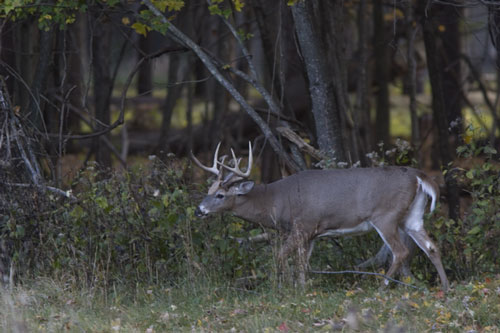 Do you have a mature buck roaming your property? You may discovered a set of large, splayed prints along the edge of a corn field, or located a couple of thigh-sized rubs during a scouting trip, or even caught a glimpse of him in July just as his velvet rack was branching out. Whatever the case may be, as the bowhunting season approaches, he is nowhere to be found. Has he been poached? Hit by a vehicle? Moved to adjacent property? Or has he simply gone nocturnal? Indeed, when big bucks remain bedded down during daylight hours, we all know they can be nearly impossible to kill.
Do you have a mature buck roaming your property? You may discovered a set of large, splayed prints along the edge of a corn field, or located a couple of thigh-sized rubs during a scouting trip, or even caught a glimpse of him in July just as his velvet rack was branching out. Whatever the case may be, as the bowhunting season approaches, he is nowhere to be found. Has he been poached? Hit by a vehicle? Moved to adjacent property? Or has he simply gone nocturnal? Indeed, when big bucks remain bedded down during daylight hours, we all know they can be nearly impossible to kill.
Do not give up hope! In most cases that trophy buck is still around, and if you are careful you can catch him flat-footed on the edge of darkness. All you have to do is learn to look in the right places.
Yearling bucks and family groups of does and fawns can generally be found feeding late in the afternoon in alfalfa fields, bean lots and other primary food sources. They are easy to pattern. Your trophy buck however is not on the scene. Why? He is feeding nearby in a secondary food source such as an overgrown pasture, a golden rod field, a thorn apple thicket or along a power line right-of-way where he will remain secluded until complete darkness. Only then will he carefully venture to the primary food source where to feed.
The trick is to position yourself out of sight and down or cross-wind to one suspected secondary food source after another. Then with a pair of high-quality light-gathering binoculars (read: expensive), glass the edges and shadows, nooks and crannies until the last scintilla of light fades from the scene. Eventually you will find him.
That buck will be bedded down before pink light. Nonetheless, wait until noon time to scout this secondary food source for tracks, rubs, and his entrance trail. Then like any other buck, it is a simple matter of backtracking until you can predict the location of his bedding grounds. Erect your treestand or ground blind as close to his suspected lair area as you dare, and then stay away until the archery opener.
Five Rules Of Pre-Season Glassing
Glassing whitetails is a great way to keep track of preferred feeding areas, travel routes, and bedding grounds without disrupting their daily routines before the season opener. The practice, however, is not fool-proof. Here are some general rules to follow.
1: Leave your mini binoculars and cheapies home. They can give you headaches and gather very little light during twilight hours.
2: Practice scent control by playing the wind, wearing knee-high rubber boots and applying scent elimination products.
3: Cover all exposed skin. Glassing with a bare head, neck, arms and hands is like waving a flashlight in the dark.
4: Don’t overdo it or he will pattern you and vanish.
5: Do not sit in your stand or ground blind until bowhunting season arrives. You will only get one chance to catch him off guard. Make sure you can legally have your bow in hand.
6: Do not tell anyone about your find. Trophy bucks attract unwanted attention.






